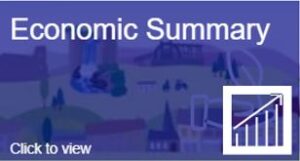 |
 |
 |
|---|
Economic Summary
The dashboard below brings together some of the main indicators detailing the economy in County Durham and provides a summary of the economic factsheets on this site with additional supporting information publicly available.
The documents we publish on this page are either legally required to be made available for inspection, for information and analysis purposes or may have been supplied by the public and so in some cases may not be fully accessible. If, for any reason, you cannot access the documents and need an alternative format, please email ina@durham.gov.uk.
Linking Economic Data: Advice
Drawing links and conclusions between the datasets detailed below must be carried out with caution as they are derived using different methodologies, cover different populations, and cover different time periods.
- Business enterprises are derived from the Inter Departmental Business Register (IDBR) (via NOMIS) which records the number of enterprises that were live at a reference date in March. Latest data is for 2023.
- Job numbers are derived from a sample survey of businesses extracted from the IDBR above (via NOMIS). Latest data is for 2022. As these estimates use an extract from the IDBR they can be linked.
- Employment statistics are estimates from the Annual Population Survey (APS) (via NOMIS). This survey is carried out quarterly with figures released on a rolling year average. The sample size for Great Britain is around 223,000 households and within County Durham it is 1,200 to 1,300 households. The latest period covers January 2023 to December 2023.
- Gross Value Added (GVA), are estimates of the increase in the value of the economy due to the production of goods and services. Latest data is for 2021.
- Gross Domestic household Income (GDHI) are estimates of amount of money that all of the individuals in the household sector have available for spending or saving after income distribution measures (for example, taxes, social contributions and benefits) have taken effect. Latest data is for 2021.
All of the above indicators are produce by or on behalf of the Office for National Statistics (ONS).
For example, linking changes in employment levels and GDHI cannot be made directly due to the differing methodologies and time periods they cover. Inferences can be made by comparing similar time periods, GDHI 2017 with employment rates for Jan 2017 – Dec 2017, for example and looking back over the available time-series. However, this can only be done with caveats explaining the differences in the methodologies used.
Additional Jobs/Labour Force Indicators
The dashboard below summarises additional indicators around jobs and the labour force in County Durham and cover:
- Employees on Zero Hour Contracts,
- Jobs demand: Unique vacancies by occupation (LightCast.IO),
- Quality of jobs: Jobs in Higher skilled occupations and employees with higher level qualifications,
- Jobs below the Living Wage
Research & Development Investment
Source: Office for National Statistics (ONS) –Estimates of R&D Investment.
The R&D investment data shows that England had the highest investment coming from businesses followed by higher education, whereas County Durham had the majority coming from Higher education i.e. Durham University, with business investment the next highest.
This demonstrates a low business R&D investment compared to national figures with the overall being artificially supported by the universities.
County Durham also had low government R&D investment and high Private Non-profit R&D investment as a proportion of the total local investment.
Investment per capita shows County Durham was extremely low at £185.6 compared to £554.5 in England, possibly due to the cheap R&D costs in universities and a higher proportion of that in the county. The following tables summarises this dataset.
